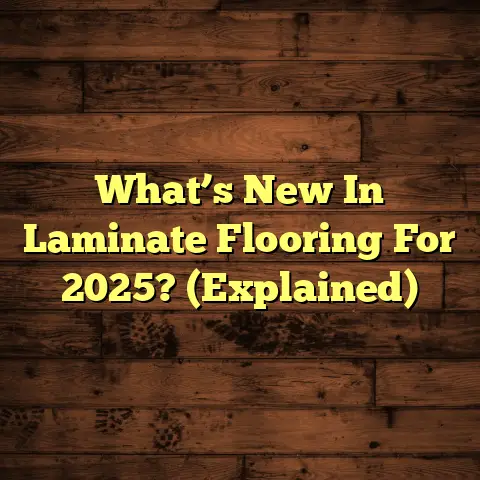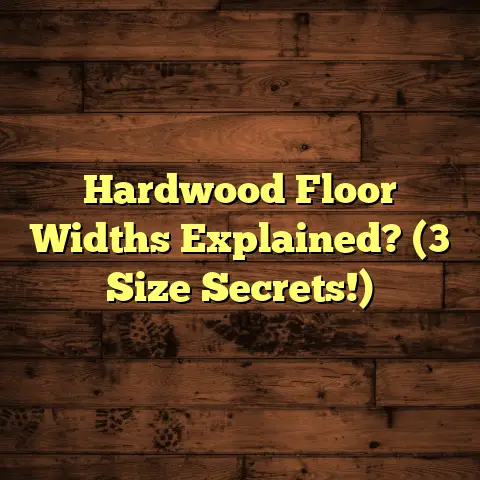Types of Floor Coverings Available? (1 Mistake Costly!)
Flooring is so much more than just what you walk on. It sets the tone for your entire space, impacts functionality, and even affects your property value. Think about it: a gorgeous hardwood floor can make a home feel warm and inviting, while a sleek tile floor can give a modern, sophisticated vibe.
But here’s the thing: choosing the right flooring can be a real minefield. There are so many options out there, and making the wrong choice can be a costly mistake, both financially and aesthetically.
One of the biggest factors, of course, is budget. We all want beautiful floors, but we also need to be realistic about what we can afford. The sweet spot? Balancing quality with cost.
Budget-Friendly Flooring Options:
Getting the Most Bang for Your Buck
Look, I get it. Remodeling can be expensive. That’s why it’s awesome that we have some great, budget-friendly options that don’t sacrifice style or durability. Let’s take a peek:
-
Vinyl: Ah, vinyl! It has come a long way from the stuff your grandma had in her kitchen. Modern vinyl, especially luxury vinyl plank (LVP) and luxury vinyl tile (LVT), is super durable, waterproof, and comes in tons of styles that mimic wood, stone, and tile. Plus, it’s easy to install, making it a great DIY project. Expect to pay anywhere from $2 to $7 per square foot for materials.
-
Laminate: This stuff is like the chameleon of flooring. It can convincingly imitate hardwood or stone at a fraction of the price. Laminate is also pretty durable and easy to clean. The downside? It’s not as water-resistant as vinyl, so it’s not ideal for bathrooms or laundry rooms. You’re looking at around $1 to $5 per square foot.
-
Carpet Tiles: Remember those drab, commercial- looking carpet squares? Forget ’em! Today’s carpet tiles come in cool patterns, colors, and textures, and they’re incredibly easy to install. Plus, if one gets stained or damaged, you can just replace that tile instead of the whole floor. Prices range from $1.50 to $8 per square foot.
These materials are appealing because they offer a balance of affordability, ease of installation (saving on labor costs), and relatively low maintenance. They’re perfect for rental properties, basements, or anywhere you want to update your floors without breaking the bank.
Section 1: Types of Floor Coverings
Alright, let’s dive into the nitty-gritty of different types of floor coverings. I’ll break it down by material and usage, so you can get a good sense of what’s out there.
1. Hardwood Flooring: The Timeless Classic
Hardwood flooring is the gold standard. There’s just something about the warmth and character of real wood that’s hard to beat. It’s classic, elegant, and can increase your home’s value.
Species and Price Points:
-
Oak: The most popular choice, oak is durable, readily available, and comes in various colors and grain patterns. Expect to pay $3 to $8 per square foot.
-
Maple: A lighter-colored wood with a smooth, modern look. It’s a bit harder than oak but can be more prone to scratches. Prices range from $4 to $9 per square foot.
-
Cherry: A rich, reddish-brown wood that adds warmth and sophistication. It’s softer than oak and maple, so it’s more susceptible to dents. Expect to pay $6 to $12 per square foot.
Engineered vs. Solid Hardwood:
-
Solid Hardwood: This is the real deal – planks made from a single piece of wood. It can be sanded and refinished multiple times, giving it a long lifespan.
-
Engineered Hardwood: Constructed from layers of wood with a hardwood veneer on top. It’s more stable than solid hardwood, making it less prone to warping or expanding in humid environments. Plus, it’s often more affordable.
Advantages and Disadvantages:
-
Advantages: Beautiful, adds value, long-lasting (especially solid hardwood), can be refinished.
-
Disadvantages: Expensive, susceptible to moisture damage, can scratch and dent, requires regular maintenance.
Maintenance and Longevity:
To keep your hardwood floors looking their best, sweep or vacuum regularly to remove dirt and debris. Use a wood floor cleaner specifically designed for hardwood, and avoid excessive moisture. With proper care, hardwood floors can last for decades, even centuries.
2. Laminate Flooring: The Budget-Friendly Mimic
Laminate flooring is a synthetic product designed to resemble hardwood or stone. It’s made of multiple layers, including a high-density fiberboard core and a decorative layer that’s printed with a realistic image.
Durability, Installation, and Cost-Effectiveness:
Laminate is surprisingly durable, resistant to scratches and stains, and easy to clean. It’s also a breeze to install, thanks to its click-lock system. And, of course, it’s much more affordable than hardwood or stone.
Potential Drawbacks:
The biggest drawback of laminate is its susceptibility to moisture damage. If water seeps into the seams, it can cause the core to swell and warp. That’s why it’s not recommended for bathrooms or laundry rooms.
3. Vinyl Flooring: The Versatile Workhorse
Vinyl flooring is a synthetic material known for its versatility, durability, and water resistance. It comes in various forms, including sheets, tiles, and planks.
Luxury Vinyl Tiles (LVT) and Sheets:
-
LVT: These individual tiles mimic the look of stone or ceramic and offer a more realistic appearance than sheet vinyl. They’re also easier to install and replace.
-
Sheet Vinyl: This comes in large rolls, minimizing seams and providing excellent water resistance. It’s a great option for bathrooms and kitchens.
Water Resistance, Comfort, and Maintenance:
Vinyl is completely waterproof, making it ideal for moisture-prone areas. It’s also softer and warmer underfoot than tile or stone. Plus, it’s super easy to clean – just sweep and mop.
Eco-Friendly Vinyl Options:
Look for vinyl flooring made from recycled materials or low-VOC (volatile organic compound) options. These are better for the environment and your indoor air quality.
4. Carpeting: The Cozy Comfort
Carpeting adds warmth, comfort, and sound insulation to any space. It’s a popular choice for bedrooms, living rooms, and playrooms.
Types of Carpeting:
-
Plush: Soft and luxurious, perfect for bedrooms.
-
Berber: Durable and stain-resistant, ideal for high-traffic areas.
-
Frieze: Textured and casual, great for hiding dirt and footprints.
Installation Costs, Comfort, and Sound Insulation:
Carpet installation can be a bit pricey, as it often requires professional installation. However, the added comfort and sound insulation are worth it for many homeowners.
Cleaning and Durability:
Carpeting requires regular vacuuming to remove dirt and allergens. You’ll also need to deep-clean it periodically to remove stains and odors. While some carpets are more durable than others, all carpets will eventually show wear and tear.
5. Tile Flooring: The Durable Classic
Tile flooring is a classic choice for kitchens, bathrooms, and entryways. It’s durable, water-resistant, and comes in a wide range of styles and colors.
Ceramic, Porcelain, and Stone Tiles:
-
Ceramic: A versatile and affordable option that’s easy to clean and maintain.
-
Porcelain: A denser and more durable type of ceramic that’s suitable for high-traffic areas and outdoor use.
-
Stone: A natural and luxurious option that adds character and value to your home.
Suitability for High-Moisture Areas:
Tile is ideal for high-moisture areas like kitchens and bathrooms because it’s completely waterproof and resistant to mold and mildew.
Installation Costs and Maintenance Tips:
Tile installation can be labor-intensive, so it’s often best left to the professionals. To keep your tile floors looking their best, sweep or vacuum regularly and mop with a tile cleaner.
6. Natural Stone Flooring: The Luxurious Touch
Natural stone flooring, such as granite, marble, and slate, adds a touch of luxury and sophistication to any space.
Materials: Granite, Marble, and Slate:
-
Granite: Extremely durable and resistant to scratches and stains, ideal for kitchens and high- traffic areas.
-
Marble: Elegant and timeless, perfect for bathrooms and entryways. However, it’s more porous than granite and can stain easily.
-
Slate: A rustic and natural-looking option that’s slip-resistant and durable.
Luxurious Appeal and Long-Term Value:
Natural stone flooring adds significant value to your home and creates a sense of luxury and permanence.
Installation Complexity and Maintenance Needs:
Installing natural stone flooring requires specialized skills and equipment, so it’s best left to the professionals. Stone floors also require regular sealing to protect them from stains and moisture.
7. Bamboo and Cork Flooring: The Eco-Friendly Choice
Bamboo and cork flooring are sustainable and eco-friendly alternatives to traditional flooring materials.
Sustainability and Growing Popularity:
-
Bamboo: A rapidly renewable resource that grows much faster than hardwood trees.
-
Cork: Harvested from the bark of cork oak trees, which regenerates every nine years.
Durability, Style Options, and Maintenance:
Both bamboo and cork are durable, comfortable underfoot, and come in a variety of styles and colors. They’re also relatively easy to maintain – just sweep or vacuum regularly and mop with a mild cleaner.
Section 2: Unique and Specialty Flooring Options
Ready to think outside the box? Let’s explore some more niche flooring types that cater to specific needs or aesthetics.
1. Epoxy Flooring: The Industrial Chic
Epoxy flooring is a durable and seamless surface made from a resin and hardener mixture. It’s commonly used in industrial settings, but it’s also gaining popularity in residential garages and basements.
Industrial Applications and Residential Use:
In industrial settings, epoxy flooring is used for its resistance to chemicals, stains, and heavy traffic. In homes, it’s often used to create a durable and easy-to- clean surface in garages and basements.
Durability, Customization, and Installation:
Epoxy flooring is incredibly durable and can withstand heavy use. It can also be customized with different colors, patterns, and textures. However, installation requires specialized skills and equipment.
2. Rubber Flooring: The Safe and Sound
Rubber flooring is a resilient and shock-absorbent surface made from natural or synthetic rubber. It’s commonly used in gyms, playrooms, and commercial spaces due to its safety features.
Common Use in Gyms, Playrooms, and Commercial Spaces:
Rubber flooring provides a cushioned surface that reduces the risk of injuries from falls. It’s also sound-absorbent, making it ideal for noisy environments.
Durability, Maintenance, and Eco-Friendly Options:
Rubber flooring is durable, easy to clean, and available in eco-friendly options made from recycled tires.
3. Concrete Flooring: The Modern Minimalist
Concrete flooring is a durable and versatile surface that can be polished, stained, or sealed to create a variety of looks. It’s a popular choice for modern homes and businesses.
Polished and Stained Concrete:
Polished concrete has a smooth, glossy finish that’s easy to clean and maintain. Stained concrete can be customized with different colors and patterns.
Durability, Maintenance, and Cost-Effectiveness:
Concrete flooring is incredibly durable and can last for decades with proper care. It’s also relatively low- maintenance and cost-effective.
4. Sustainable and Recycled Flooring: The Green Choice
Sustainable and recycled flooring options are made from recycled materials or renewable resources. These options are better for the environment and can add a unique touch to your home.
New and Innovative Materials:
Examples include flooring made from recycled glass, reclaimed wood, or bamboo.
Benefits and Potential Drawbacks:
These options are eco-friendly and can add a unique look to your home. However, they may be more expensive than traditional flooring materials.
Section 3: Costly Mistakes to Avoid
Okay, let’s talk about the elephant in the room: mistakes. I’ve seen it all in my years as a flooring contractor, and trust me, some mistakes are way more costly than others. Here’s what to watch out for:
1. Ignoring Long-Term Costs: The Penny-Wise, Pound-Foolish Trap
It’s tempting to focus solely on the initial purchase price of flooring, but that’s a recipe for disaster. You need to consider the long-term costs, including:
- Maintenance: How much will it cost to clean and maintain the flooring over time?
- Durability: How long will the flooring last before it needs to be replaced?
- Replacement: What will it cost to replace the flooring when it eventually wears out?
Sometimes, spending a bit more upfront on a higher-quality material can save you money in the long run.
2. Choosing the Wrong Material for the Space: The Functionality Fumble
This is a big one! Different materials perform differently in various environments. For example:
- Moisture Levels: Hardwood and laminate are not ideal for bathrooms or basements, where moisture levels are high.
- Foot Traffic: Soft carpets are not suitable for high-traffic areas like hallways or entryways.
- Pets: Some flooring materials are more resistant to scratches and stains from pets than others.
Think carefully about how the space will be used and choose a flooring material that’s appropriate for the environment.
3. Overlooking Installation Costs: The Hidden Expense
Installation costs can vary widely depending on the material and the complexity of the job. Don’t make the mistake of only budgeting for the cost of the flooring itself.
Get quotes from multiple contractors and factor in the cost of installation before making a decision. And be sure to ask about any potential hidden fees, such as subfloor preparation or disposal of old flooring.
4. Neglecting Samples and Testing: The “Looks Good Online” Illusion
Never, ever, ever choose flooring based solely on pictures you see online or in a catalog. Colors and textures can look very different in person, and you need to see how the material works in your space.
Order samples of the flooring you’re considering and test them out in the intended environment. See how they look in different lighting conditions, how they feel underfoot, and how they hold up to spills and stains.
Conclusion: Flooring Wisdom for the Win!
Wow, we covered a lot of ground! From budget-friendly options to luxurious natural stone, there’s a floor covering out there for every style and budget.
The key takeaway? Don’t rush into a decision. Take the time to research your options, consider your needs and budget, and avoid those costly mistakes I mentioned.
By making informed decisions and considering the unique requirements of each space, you can create beautiful and functional floors that you’ll love for years to come. Happy flooring!





